1996 CHEVROLET TAHOE mirror
[x] Cancel search: mirrorPage 102 of 403
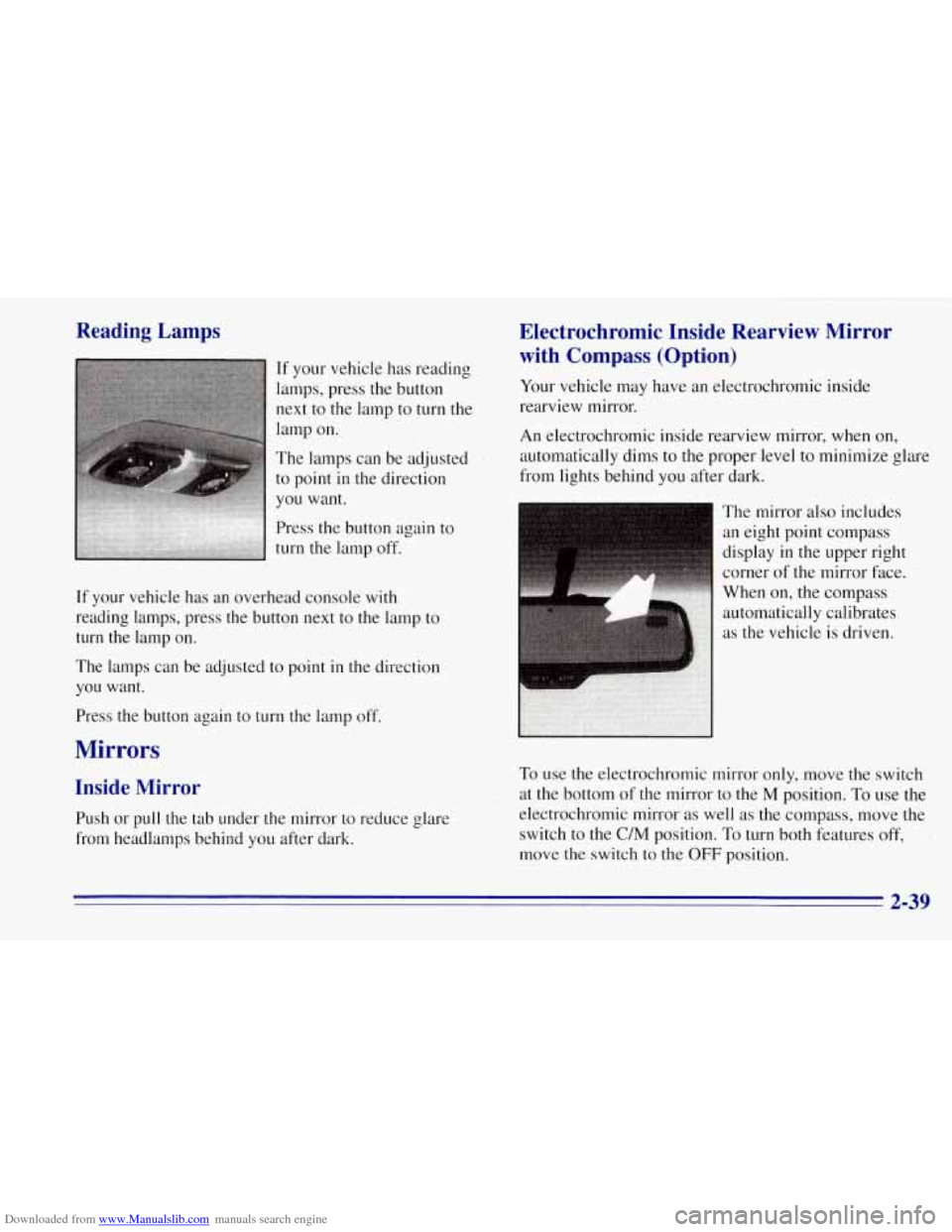
Downloaded from www.Manualslib.com manuals search engine Reading Lamps
If your vehicle has reading
lamps, press the button
next to the lamp
to turn the
lamp on.
The lamps can be adjusted
to point in the direction
you want.
Press the button again to
turn the lamp off.
If your vehicle has an overhead console with
reading lamps, press the button next to the lamp to
turn the lamp on.
The lamps can be adjusted to point in the direction
you want.
Press the button again to turn the lamp off.
Mirrors
Inside Mirror
Push or pull the tab under the mirror to reduce glare
from headlamps behind
you after dark.
Electrochromic Inside Rearview Mirror
with Compass (Option)
Your vehicle may have an electrochromic inside
rearview mirror.
An electrochromic inside rearview mirror, when on,
automatically dims to the proper level to minimize glare
from lights behind you after dark.
The mirror also includes
an eight point compass
display in the upper right
corner of the mirror face.
When
on, the compass
automatically calibrates
as the vehicle is driven.
To use the electrochromic mirror only, move the switch
at the bottom of
the mirror to the M position. To use the
electrochromic mirror as well as the compass, move the
switch to the
C/M position. To turn both features off,
move the switch to the
OFF position.
2-39
Page 103 of 403

Downloaded from www.Manualslib.com manuals search engine Compass Operation
When the ignition is on and the mirror switch is in the
C/M position, the compass display will show two
character boxes for approximately two seconds. If, after
two seconds, the display does not show a compass
heading (“N” for North, for example), there may be a
strong magnetic field interfering with the compass. Such
interference may include magnetic antenna mounts, a
magnetic note pad holder, or a similar magnetic item. If
removing these items does not correct the condition,
see
your GM dealer for assistance.
When cleaning the mirror, use a paper towel or similar
material dampened with glass cleaner.
Do not spray
glass cleaner directly on the mirror as that may cause
liquid cleaner
to enter the mirror housing.
Compass Variance
Under certain circumstances, as during a long distance
cross-country trip, it will be necessary to adjust the
compass to compensate for compass variance. Compass
variance is the difference between earth’s magnetic
North and true geographic North. If not adjusted to
account for compass variance, your compass could give
false readings.
To adjust for compass variance:
1. Use the CAL switch located at the bottom of the
mirror housing near the
odoff switch. A safety pin
or a paper clip can be used to press the button. Press
and hold the CAL switch for five seconds until a
.
zone number appears in the display.
2. Find your current location and variance zone number
on the following zone map.
2-40
Page 104 of 403
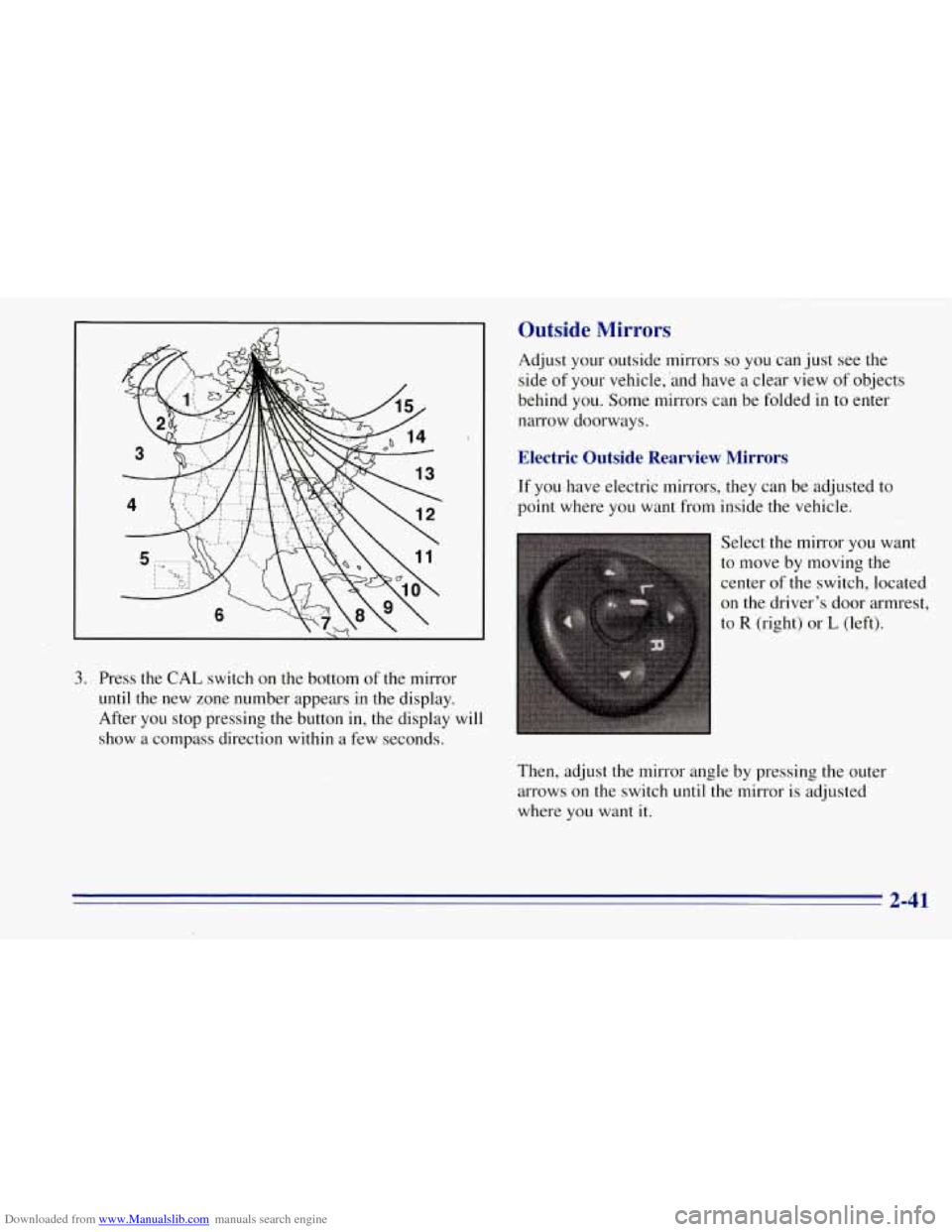
Downloaded from www.Manualslib.com manuals search engine 3. Press the CAL switch on the bottom of the mirror
until the new zone number appears in the display.
After you stop pressing the button in, the display will
show a compass direction within a few seconds.
Outside Mirrors
Adjust your outside mirrors so you can just see the
side
of your vehicle, 'and have a clear view of objects
behind
you. Some mirrors can be folded in to enter
narrow doorways.
Electric Outside Rearview Mirrors
If you have electric mirrors,, they can be adjusted to
point where you want from inside the vehicle.
Select
the mirror you want
to move by moving the
center
of the switch, located
on the driver's door armrest,
to
R (right) or L (left).
Then, adjust the mirror angle by pressing the outer
arrows on the switch
until the mirror is adjusted
where you want it.
Page 105 of 403
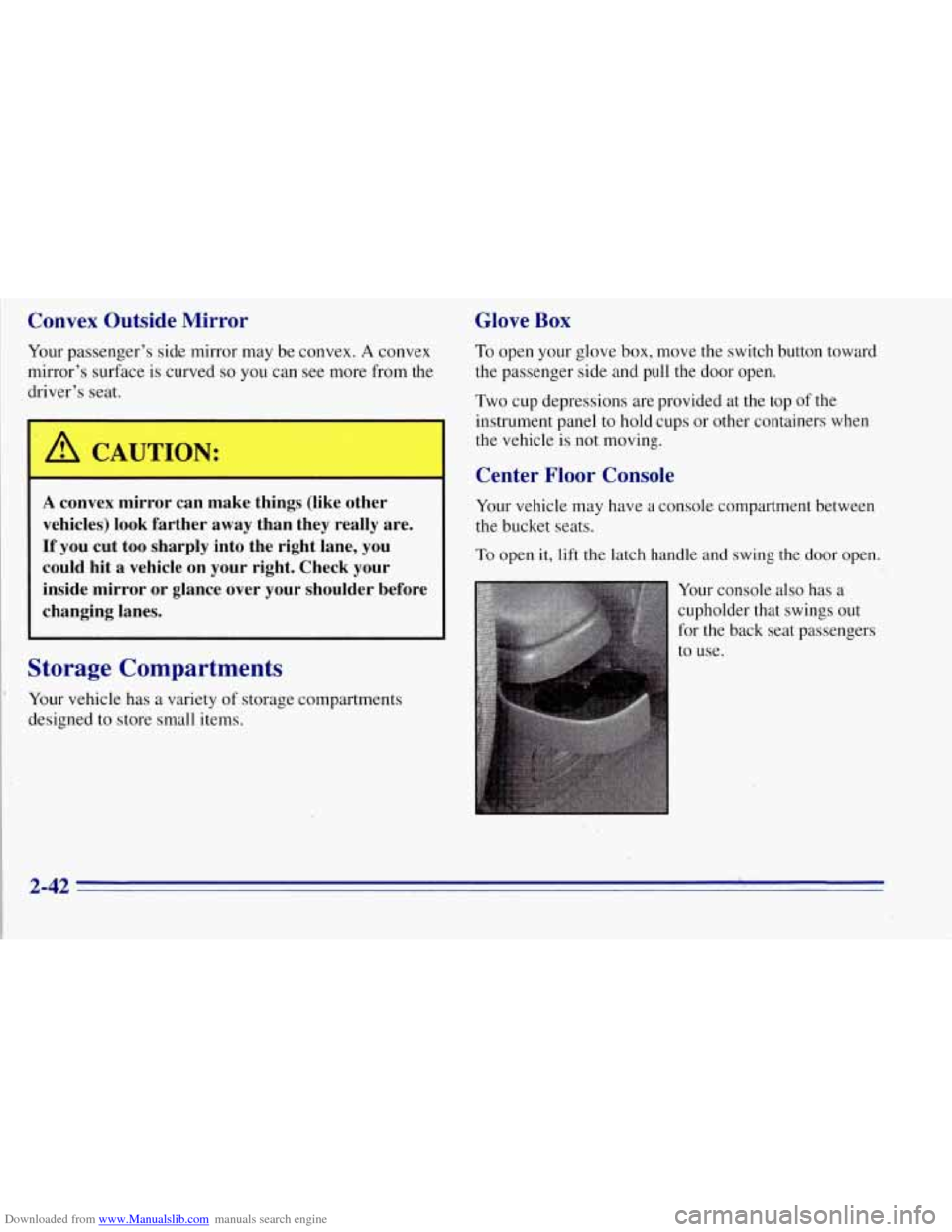
Downloaded from www.Manualslib.com manuals search engine Convex Outside Mirror
Your passenger’s side mirror may be convex. A convex
mirror’s surface is curved
so you can see more from the
driver’s seat.
I A CAUTION:
A convex mirror can make things (like other
vehicles) look farther away than they really are.
If you cut too sharply into the right lane, you
could hit a vehicle on your right. Check your
inside mirror
or glance over your shoulder before
changing lanes.
Storage Compartments
Your vehicle has a variety of storage compartments
designed to store small items.
Glove Box
To open your glove box, move the switch button toward
the passenger side and pull the door open.
Two cup depressions are provided at the top
of the
instrument panel to hold cups or other containers when
the vehicle is not moving.
Center Floor Console
Your vehicle may have a console compartment between
the bucket seats.
To open it, lift the latch handle and swing the door open.
Your console also has a
cupholder that swings out
for the back seat passengers
to use.
2-42
Page 116 of 403

Downloaded from www.Manualslib.com manuals search engine Sun Visors
To block out glare, you can swing down the visors. You
can also swing them out
to help block glare at the front
and side windows.
Your visor may have a strap to hold small items, such
as maps.
Some visors have an
extender on the inside edge.
When
the visor is down,
pull the extender out for
extra glare coverage at the
front or side.
Some visors have mirrors with lights. If the mirror has
lights, they will come on when you lift the mirror cover.
Power Outlets
You may have two power outlets near the cigarette
lighter.
To access these outlets, pull down the covers. Use
these outlets to power mobile telephones or other devices
designed
to operate with vehicle electrical systems.
2-53
Page 171 of 403

Downloaded from www.Manualslib.com manuals search engine Check your mirrors, glance over your shoulder and
start your
left lane change signal before moving out
of the right lane to pass.,When you are far enough
ahead
of the passed vehicle to see its front in your
inside mirror, activate your right lane change signal
and move back into the right lane. (Remember that
if
your right outside mirror is convex, the vehicle you
just passed may seem to be ,farther away from you
than it really is.)
on two-lane roads. Reconsider before passing the
next vehicle.
Try not to pass more than one vehicle at a time
0 Don’t overtake a slowly moving vehicle too rapidly.
Even though the brake lamps are not flashing, it may
be slowing down or starting to turn.
0 If you’re being passed, make it easy for the
following driver to get ahead
of you. Perhaps you
can ease a little to
the right.
Loss of Control \
Let’s review what driving experts say about what
happens when the three control systems (brakes, steering
and acceleration) don’t have enough friction where
the
tires meet the road to do what the driver has asked.
In any emergency, don’t give up. Keep trying to steer and
constantly seek
an escape route or area of less danger. __
Skidding
In a skid, a driver can lose control of the vehicle.
Defensive drivers avoid most skids by taking reasonable
care suited to existing conditions, and by not “overdriving”
those conditions. But skids are always possible.
The three types of skids correspond to your vehicle’s
three control systems:
In the braking skid, your wheels
aren’t rolling. In the steering or cornering skid, too
much speed or steering
in a curve causes tires to slip and
lose cornering force. And in the acceleration skid, too
much throttle causes the driving wheels
to spin.
A cornering skid and an acceleration skid are best
handled by easing your foot off the accelerator pedal.
4-12
Page 172 of 403
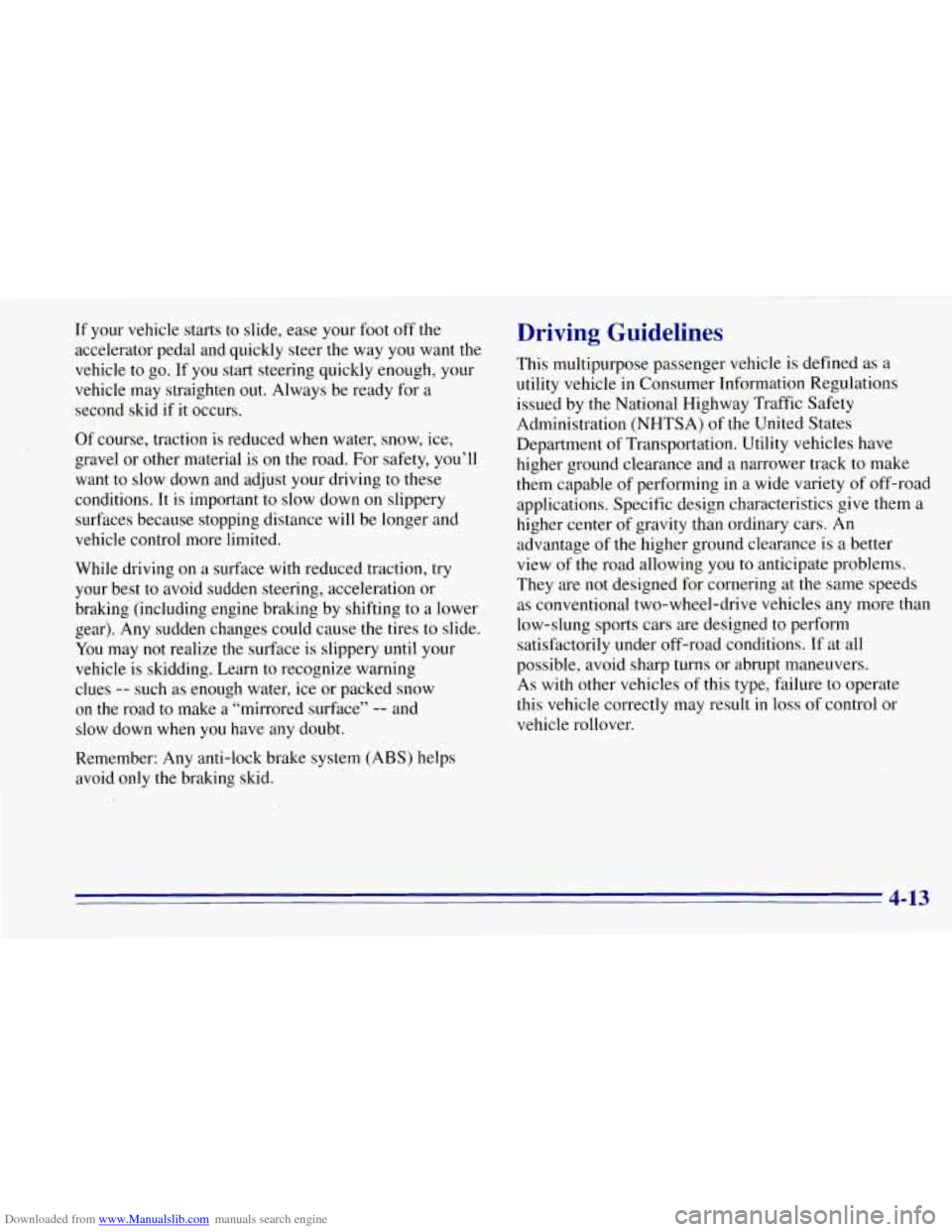
Downloaded from www.Manualslib.com manuals search engine If your vehicle starts to slide, ease your foot off the
accelerator pedal and quickly steer the way
you want the
vehicle to go. If you start steering quickly enough, your
vehicle may straighten out. Always be ready for a
second skid if
it occurs.
Of course, traction is reduced when water, snow, ice,
gravel or other material is on the road. For safety, you’ll
want to slow down and adjust your driving to these
conditions. It
is important to slow down on slippery
surfaces because stopping distance will be longer and
vehicle control more limited.
While driving on a surface with reduced traction, try
your best to avoid sudden steering, acceleration or
braking (including engine braking by shifting to a lower
gear). Any sudden changes could cause the tires to slide.
You may not realize the surface is slippery until your
vehicle is skidding. Learn to recognize warning
clues
-- such as enough water, ice or packed snow
on the road to make a “mirrored surface’’
-- and
slow down when you have any doubt.
Remember: Any anti-lock brake system (ABS) helps
avoid only the braking skid.
Driving Guidelines
This multipurpose passenger vehicle is defined as a
utility vehicle in Consumer Information Regulations
issued by the National Highway Traffic Safety
Administration
(NHTSA) of the United States
Department of Transportation. Utility vehicles have
higher ground clearance and a narrower track
to make
them capable
of performing in a wide variety of off-road
applications. Specific design characteristics give them a
higher center of gravity than ordinary cars. An
advantage of the higher ground clearance is a better
view of the road allowing you
to anticipate problems.
They are not designed for cornering at the same speeds
as conventional two-wheel-drive vehicles any more than
low-slung sports cars
are designed to perform
satisfactorily under off-road conditions. If at all
possible, avoid sharp turns or abrupt maneuvers.
As with other vehicles of this type, failure to operate
this vehicle correctly may result in loss
of control or
vehicle rollover.
4-13
Page 187 of 403
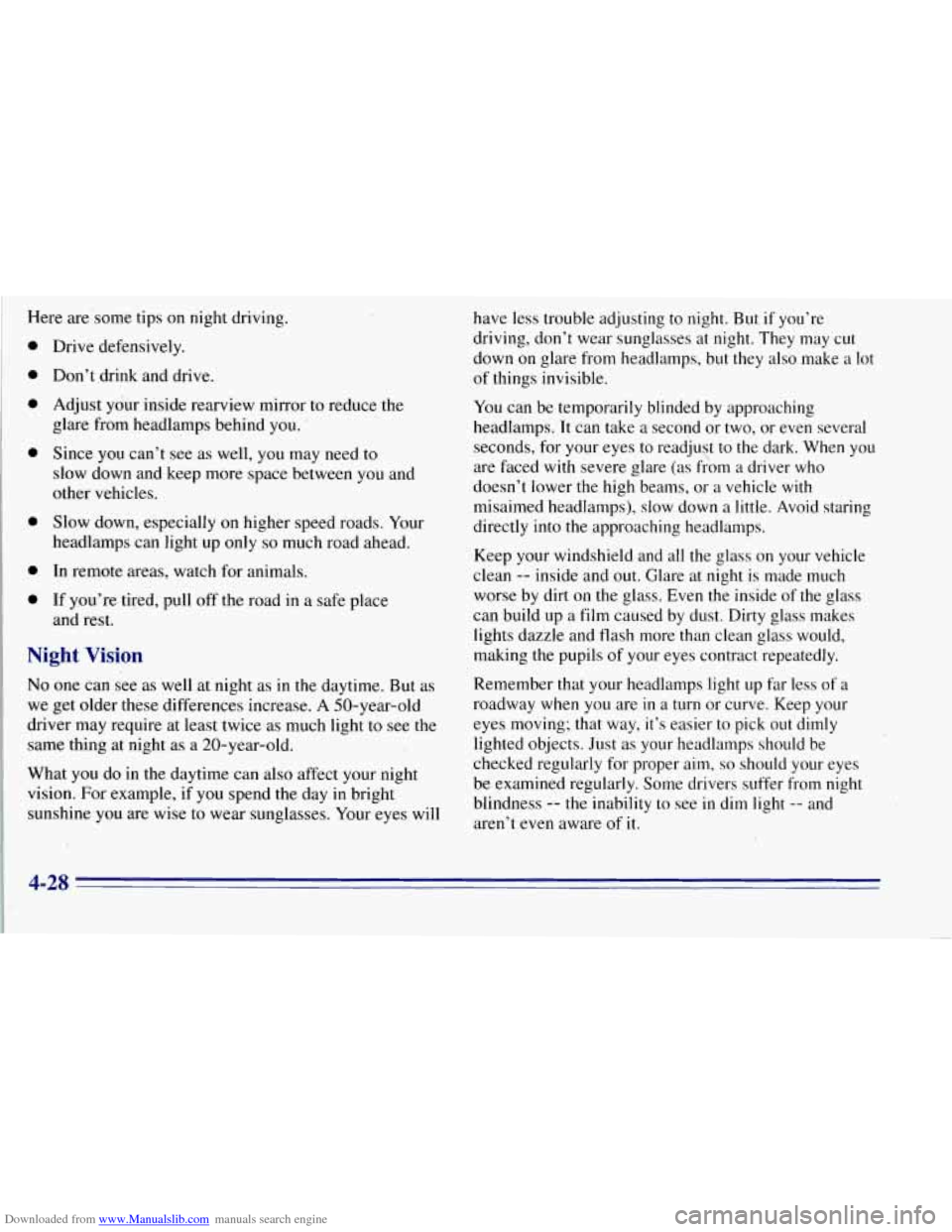
Downloaded from www.Manualslib.com manuals search engine Here are-some tips on night driving.
0
0
0
0
0
0
0
Drive defensively.
Don’t ,drink and drive.
Adjust your inside rearview mirror to reduce the
glare from headlamps behind you.
.
Since you can’t see as well, you may need to
slow down and keep more space between you and
other vehicles.
Slow down, especially on higher speed roads. Your
headlamps can light up
only so much road ahead.
In remote areas, watch for animals.
If you’re tired, pull off the road in a safe place
and rest.
Night Vision
No one can see as well at night as in the daytime. But as
we get older these differences increase.
A 50-year-old
driver may require at least twice as much light to
see the
same thing at night as a 20-year-old.
What you do
in the daytime can also affect your night
vision. For example, if you spend the day in bright
sunshine you are wise to wear sunglasses. Your eyes will have less trouble adjusting to night.
But,if you’re
driving, don’t wear sunglasses at.night. They may cut
down on glare from headlamps, but they also make a
lot
of things invisible.
You can be temporarily blinded by approaching
headlamps. It can take a second or two, or even several
seconds, for your eyes to readjust to the dark. When you
are faced with severe glare (as from a driver who
doesn’t lower the high beams, or a vehicle
with
misaimed headlamps), slow down a little. Avoid staring
directly into the approaching headlamps.
Keep your windshield and all the glass on your vehicle
clean
-- inside and out. Glare at night is made much
worse by dirt
on the glass. Even the inside of the glass
can build up a film caused by dust. Dirty glass makes
lights dazzle and flash more than clean glass would,
making the pupils
of your eyes contract repeatedly.
Remember that your headlamps light up far less
of a
roadway when
you are in a turn or curve. Keep your
eyes moving; that way, it’s easier to pick out dimly
lighted objects. Just as your headlamps should be
checked regularly for proper aim,
so should your eyes
be examined regularly. Some drivers suffer from night
blindness
-- the inability to see in dim light -- and
aren’t even aware of it.
4-28